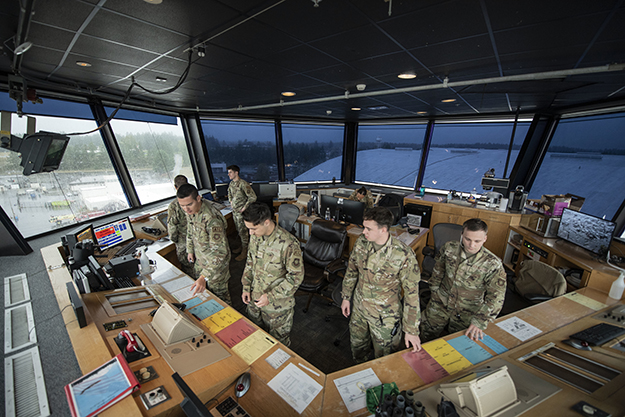JOINT BASE LEWIS McCHORD -More than 18,000 flights happen here at McChord Field every year. Fog, snow, rain or shine, C-17 Globemaster IIIs are taking to the skies to fulfill the rapid global mobility mission set that America's Airlift Wing upholds. A huge part of this is thanks to the 62d Operation Support Squadron's air traffic control airmen.
"There are a lot of things that we do that people don't know about," said U.S. Air Force Staff Sgt. Kayla Morales, an ATC senior watch supervisor with the 62d OSS. "A lot of times when I talk to people about ATC, they assume we're the ones out there guiding the planes with the cones but in reality, we're in a tower or in a radar on the radio talking with the pilot. It's a lot more complicated than people may think."
The ATC tower has three different positions: ground control, local control, and flight data. Ground control involves taxiing aircraft out of their parking spots to wherever they need to go, as well as communicating with emergency vehicles. Local control involves answering phone calls from other facilities, like airfield management or coordinating with Seattle Approach control for departures.
"Here at McChord we're responsible for a five-mile radius of airspace," said Senior Airman Tanner Boyd, an air traffic controller with the 62d OSS. "We talk to aircraft that come within our airspace which is from the surface level to 2,800 feet. To enter our airspace, they must have two-way communication."
Boyd explains how every airspace has a specific frequency that the pilot of the aircraft has access to, similar to dialing a phone number. This frequency allows a two-way communication between the tower that air traffic controllers work from and the aircraft. They can be talking to as many as four pilots across multiple different aircrafts at one time.
"We make sure our aircraft get out in a timely manner," said Morales. "These C-17's have a great impact on what's going on worldwide. If a plane needs to go out, it will go out while considering what's going on weather wise."
Morales explains how flights continue in relatively poor weather; however, the aircraft do have their limitations. According to her, safety is the most important thing. If the weather degrades to a certain point, the aircraft will not depart. If there are proposed arrivals during poor weather, they will divert them to other airports.
In order to be an ATC airman, a score of at least a 55 in the general portion of the armed services vocational aptitude battery is required along with getting medically cleared. After basic military training, ATC airmen go to technical training at Keesler Air Force Base, Mississippi. During this, they spend roughly six hours a day carrying out their ATC duties in a simulated environment. After months of learning the basic rules of ATC, students are required to show instructors that they can demonstrate what they've learned in a simulated environment.
Upon arriving to their first duty station, airmen will become proficient in all three ATC positions.
"People say that ATC is one of the most stressful jobs. The most stressful part of ATC, to me, has been the training," said Morales. "In technical training there was so much information that we needed to retain in what felt like a short period of time. After graduation, you go to your first duty location where you really learn what it takes to be an air traffic controller."
Morales explains how depending on the workload and complexity of the mission, on-the-job and upgrade training can take anywhere from six to twelve months. According to her, the cohesiveness of the crew plays a major role on how stressful the work is.
An air traffic controller's responsibility doesn't end at directing the movements of the aircraft. It also includes giving flight and landing information, constantly relaying weather reports, and plotting the position of each aircraft and computing aircraft speed.
"It's a very different language. The order in which we say things in the radio is very specific," said Morales. "We can't just show the pilot what we're seeing, we have to explain it to them using our words which is a different challenge in itself."
Pilots around the globe put their trust in ATC airmen to keep them safe on the ground and in the air. Air traffic controllers at McChord play a key role in providing rapid global mobility by having airmen operate the ATC tower 24 hours a day, seven days a week, 365 days a year; ready to make fast, safe and precise decisions within seconds.





Read Comments